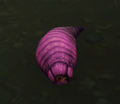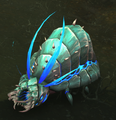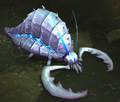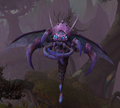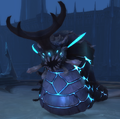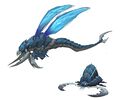Gorm
- For the lore character, see Gorm (Nazjatar).
Gorm are giant bugs found in and are native to[1][2] Ardenweald, where they are responsible for helping the process of decomposition and decay.[3] Their purpose is to devour discarded wildseeds[4], and unused parts of the forest, allowing new life to grow there. Expended wildseeds are thrown to Gormhive for the gorm to consume.[5]This is done through their digestive juices that dissipate the anima in their food.[6] They are drawn to consume anything that is lacking anima.[7] The gorm only know to consume, and normally the Night Fae keep them under control. Spriggans use bits of anima-less detritus tied to the end of sticks to steer the gorm they use as mounts.[8]
However, with the Night Fae busy responding to the anima drought, there aren't enough resources to keep the gorm in check and they've started growing out of control, becoming a threat to Ardenweald instead of one of its natural mechanisms.[9] Due to the anima drought, even the land has become a source of food for them,[10] and they have begun chewing at the edges of Ardenweald itself.[11] This can cause parts of the land to collapse or break away from Ardenweald.[10] A few gorm have found and consumed wildseeds that still contain ancient nature spirits—an act that grants them the spirits' strength and intelligence. Gorm who have consumed such wildseeds can gain the ability to speak.[12][11]
The parts of gorm are used for a variety of purposes by the crafters and artisans of Ardenweald. Gorm gris, a type of ambergrease[13] that a gorm may regurgitate after eating,[14] is used in construction, mending, crafts, and even as an addition to rations.[13] Gorm husks that have been soaked in running water for several days can be shaped into high-quality armor,[15] while gorm claws and stingers can be made into sharp-edged weapons that never break. A person who creates equipment out of gorm parts is known as a gormsmith.[16] In the absence of a matriarch, the fae egg-tenders are able to control the hive.[17] Gorm can be rounded up with lures made from culexwood, which requires an offering, usually song, for the tree to willingly give its wood.[18]
While some gorm (usually gormlings) are kept domesticated,[14] wild gorm grow in hives across Ardenweald, including the Creeping Hive, Gormhive, Crumbled Ridge, and Dusty Burrows, and likely previously Blackthorn Grove. In the absence of a matriarch, gorm egg-tenders are the leaders of a hive, and they can turn into queens.[19] The wild gorm encroach across the land and have invaded both Tirna Scithe and the abandoned Tirna Noch.
The sting of a flying gorm is incredibly painful and can cause temporary paralysis, even to creatures much larger than the gorm itself.[20]
Groups
- The Darkwarren gorm are inhabiting the place of the same name in Ardenweald. The place has been overrun and the gorm dealt with.[21][22] They are found in Creeping Hive which might be an alternate name for the Darkwarren area.
- The Dustwilt gorm are found near and at Tirna Scithe.
- The Spinemaw gorm are found in the Mists of Tirna Scithe.
As a mount
- Main article: Gorm mounts
As a companion pet
 [Amaranthine Stinger] has a chance to drop from Gralebboih in the Maw during the Tormentors of Torghast event.
[Amaranthine Stinger] has a chance to drop from Gralebboih in the Maw during the Tormentors of Torghast event.- Decay Grub and Gorm Rootstinger can be caught from pet battles in Ardenweald.
 [Gloober, as G'huun] is purchased from Master Clerk Salorn for 250
[Gloober, as G'huun] is purchased from Master Clerk Salorn for 250  once 2 Star Lake Amphitheater rares are defeated.
once 2 Star Lake Amphitheater rares are defeated. [Gorm Harrier] is looted from Aerto's Body in Ardenweald.
[Gorm Harrier] is looted from Aerto's Body in Ardenweald. [Gorm Needler] drops from Deifir the Untamed in Ardenweald.
[Gorm Needler] drops from Deifir the Untamed in Ardenweald. [Grubby] is rewarded to kyrian members from
[Grubby] is rewarded to kyrian members from  [60] A New Age.
[60] A New Age. [Hungry Burrower] has a chance to drop from
[Hungry Burrower] has a chance to drop from  [Wild Hunt Supplies].
[Wild Hunt Supplies]. [Invasive Buzzer] has a chance to drop from
[Invasive Buzzer] has a chance to drop from  [War Chest of the Wild Hunt] during Night Fae Assaults in the Maw.
[War Chest of the Wild Hunt] during Night Fae Assaults in the Maw. [Lavender Nibbler] drops from Gormbore in Ardenweald.
[Lavender Nibbler] drops from Gormbore in Ardenweald. [Spinemaw Gormling] is a rare drop from Tred'ova in mythic Mists of Tirna Scithe.
[Spinemaw Gormling] is a rare drop from Tred'ova in mythic Mists of Tirna Scithe.
As a hunter pet
- Main articles: Carapid, Wasp#As a hunter pet
Gorm are tamable by hunters as part of two different pet families. The medium-sized gorm are classed as carapids; winged gorm are classed as wasps.
Notes and trivia
- In
 [60D] Trading Favors: Tirna Scithe, Finder Ta'sul states that the brokers know what it looks like when a gorm infests a world.
[60D] Trading Favors: Tirna Scithe, Finder Ta'sul states that the brokers know what it looks like when a gorm infests a world. - During development, gorm consumed anima like most animals in the Shadowlands, and their sudden aggressiveness was caused by starvation rather than overconsumption.
- Concept art refers to them as Ardenweald Composters.[23]
- The gorm came about early in Ardenweald's development process when the artists were discussing the zone's ecology and creatures. As they talked about the natural cycle of the forest, they came up with the idea of the gorm as the mechanism of decomposition. According to character artist Jongmo Nam, a lot of thought went into the gorm's design since they had to feel real and familiar, but at the same time mystical and new, much like Ardenweald as a whole. Nam achieved this by combining parts from different real insects; for example, their antennae are derived from moths, while their horns are based on deer bugs. Nam gave the creatures "dreamy" colors to reflect the anima-based diet they had at the time.[3]
- They bear some similarity to devourers in both color scheme and lore regarding anima consumption, though at different extremes: where devourers are drawn to an abundance of anima, gorm are drawn to an absence of it.
- Gorm Matriach models share some resemblance with G'huun's model.
- The word "culex", used for the culexwood for the gorm lures, is a genus of mosquito.
Speculation
This article or section includes speculation, observations or opinions possibly supported by lore or by Blizzard officials. It should not be taken as representing official lore.
|
- The process of gorm matriarchs gaining power from devouring wildseeds containing nature spirits bears some resemblance to the process various trolls have used to steal the powers of loa and wild gods.
- The similar appearance between gorm matriarchs and patriarchs to G'huun may mean there's some connection between the two. Alternatively this may simply be a convenient reuse of an animation skeleton.
Gallery
References
- ^
 [60W] Baker's Dozen
[60W] Baker's Dozen
- ^
 [60] Piercing the Shell
[60] Piercing the Shell
- ^ a b Garth Holden 2020-08-20. A deep dive into Ardenweald, the Shadowlands realm of hibernation. SA Gamer. Retrieved on 2020-08-27.
- ^ The Art of World of Warcraft: Shadowlands, pg. 119
- ^
 [60] Anima Instincts
[60] Anima Instincts
- ^
 [60] Acid Reflux
[60] Acid Reflux
- ^
 [55-60] Nothing Goes to Waste
[55-60] Nothing Goes to Waste
- ^
 [Spinemaw Gladechewer]
[Spinemaw Gladechewer]
- ^ Wam 2020-08-20. Ardenweald Deep Dive With Ely Cannon. GamerBraves. Archived from the original on 2020-09-25.
- ^ a b
 [Battered Journal]
[Battered Journal]
- ^ a b Tred'ova
- ^
 [55-60] When a Gorm Eats a God
[55-60] When a Gorm Eats a God
- ^ a b
 [55-60] Supplies Needed: Amber Grease
[55-60] Supplies Needed: Amber Grease
- ^ a b
 [55-60] Collection Day
[55-60] Collection Day
- ^
 [55-60] Supplies Needed: More Husks!
[55-60] Supplies Needed: More Husks!
- ^ Gormsmith Cavina
- ^
 [55-60] Tending to the Tenders
[55-60] Tending to the Tenders
- ^
 [55-60] Gifts of the Forest
[55-60] Gifts of the Forest
- ^
 [55-60] Tending to the Tenders
[55-60] Tending to the Tenders
- ^
 [Gorm Harrier]
[Gorm Harrier]
- ^ Darkwarren Overrun
- ^ Campaign: Darkwarren Finality
- ^ BlizzCon 2019: World of Warcraft: Shadowlands art gallery. Blizzard Watch. Retrieved on 2020-06-04.
| ||||||||||||||||||||||||||||||||||||||||||||||||||||||||||||||||||||||||||||


